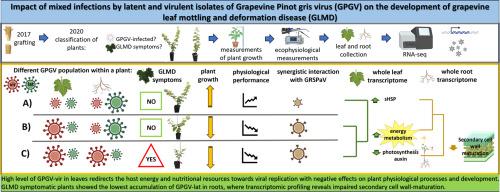病毒种群动态和宿主重编程:对葡萄叶片斑驳和变形病(GLMD)发展的见解
IF 6.8
Q1 PLANT SCIENCES
引用次数: 0
摘要
葡萄灰比诺病毒(GPGV)是一种与葡萄叶片斑驳和变形病(GLMD)相关的新型葡萄病毒。该病毒由遗传上不同的变体组成,毒性较强的形式导致严重疾病,而潜伏的形式与轻度或无症状感染有关。然而,不同病毒株混合感染的存在会影响病毒与寄主植物之间的分子相互作用,从而决定疾病的爆发。本研究以有症状和无症状的葡萄植株为材料,研究了gpgv侵染植株的生理和分子机制。所有嫁接植株都携带GPGV毒株和潜伏株的混合群体,症状表达与来源不一致。植物的叶子和根含有不同的GPGV种群。高毒力GPGV分离物在叶片中的积累将宿主的能量和营养资源转向病毒的复制和组装。这种转变对植物的生理过程和发育产生负面影响,与GLMD疾病无关。相反,有GLMD症状的植株根系中潜伏GPGV分离物的积累最少,转录组学分析显示次生细胞壁成熟受损。有趣的是,发生在GPGV和葡萄葡萄茎侵蚀相关病毒(GRSPaV)之间的宿主内病毒-病毒相互作用可能会重新排列GPGV变体群体,并可能在疾病爆发中发挥关键作用。本文章由计算机程序翻译,如有差异,请以英文原文为准。

Viral population dynamics and host reprogramming: Insights into grapevine leaf mottling and deformation disease (GLMD) development
Grapevine Pinot gris virus (GPGV) is an emerging grapevine virus associated with the grapevine leaf mottling and deformation disease (GLMD). The virus consists of genetically distinct variants, with the more virulent forms causing severe disease and the latent ones linked to mild or asymptomatic infections. However, the existence of mixed infections with different viral strains could affect the molecular interplay between the virus and its host plant and determine the disease outbreak. Here, the physiological and molecular mechanisms underlying disease manifestation were investigated in plants obtained from the graft of GPGV-infected materials originated from symptomatic and asymptomatic vines. All grafted plants carried a mixed population of GPGV virulent and latent isolates, and the symptom expression did not consistently match the source. Leaves and roots within a plant harboured different GPGV population. Higher accumulation of virulent GPGV isolates in leaves redirected the host energy and nutritional resources towards viral replication and assembly. This shift negatively affected plant physiological processes and development, independently of GLMD disease. On the opposite, GLMD symptomatic plants showed the lowest accumulation of the latent GPGV isolates in roots, where transcriptomic profiling reveals impaired secondary cell wall maturation. Interestingly, intrahost virus-virus interactions, occurring between GPGV and the grapevine rupestris stem pitting-associated virus (GRSPaV), could rearrange the population of GPGV variants with a possible key role in the disease outbreak.
求助全文
通过发布文献求助,成功后即可免费获取论文全文。
去求助
来源期刊

Plant Stress
PLANT SCIENCES-
CiteScore
5.20
自引率
8.00%
发文量
76
审稿时长
63 days
期刊介绍:
The journal Plant Stress deals with plant (or other photoautotrophs, such as algae, cyanobacteria and lichens) responses to abiotic and biotic stress factors that can result in limited growth and productivity. Such responses can be analyzed and described at a physiological, biochemical and molecular level. Experimental approaches/technologies aiming to improve growth and productivity with a potential for downstream validation under stress conditions will also be considered. Both fundamental and applied research manuscripts are welcome, provided that clear mechanistic hypotheses are made and descriptive approaches are avoided. In addition, high-quality review articles will also be considered, provided they follow a critical approach and stimulate thought for future research avenues.
Plant Stress welcomes high-quality manuscripts related (but not limited) to interactions between plants and:
Lack of water (drought) and excess (flooding),
Salinity stress,
Elevated temperature and/or low temperature (chilling and freezing),
Hypoxia and/or anoxia,
Mineral nutrient excess and/or deficiency,
Heavy metals and/or metalloids,
Plant priming (chemical, biological, physiological, nanomaterial, biostimulant) approaches for improved stress protection,
Viral, phytoplasma, bacterial and fungal plant-pathogen interactions.
The journal welcomes basic and applied research articles, as well as review articles and short communications. All submitted manuscripts will be subject to a thorough peer-reviewing process.
 求助内容:
求助内容: 应助结果提醒方式:
应助结果提醒方式:


